Trust is the cornerstone of long-distance relationships.
Without the proximity of in-person purchases in brick-and-mortar stores, trust becomes vital in your connection to your online customers.
Luckily, you can manage and convey trust on your site, as one of the dynamics of the Conversion Framework. Our Framework is built around the potential customer’s needs, interest, motivations, and objections.
The need to feel secure and trust the product’s seller is fundamental for a visitor. Every visitor to your online or offline store comes to you with specific intimidations and fears. They do not want to be cheated, sold at, or ripped off somehow; they wish to have an enjoyable, simple shopping or browsing experience.
Visitors come with a purpose, and your primary goal should be to ease the conversion process as much as possible. If you are able to establish trust with your customers successfully, you build their confidence in your company. The more confidence a customer has in your company, the more likely it is they will do business with you again. Even though getting a conversion from a first-time customer is essential, repeat customers are more valuable. The conversion value is multiplied if you are able to gain customer loyalty.

JanSport has an Instagram gallery with pictures of customers carrying their bags.
Achieving trust with the skeptical buyer is not always an easy matter.
The more financial investment a product or service requires, the more difficult it is to gain trust because the level of skepticism increases as the price tag and investment rises.
Stores that sell jewelry online report less than 0.5% average conversion rate. Does that number reflect only the lack of trust a visitor may have? Not necessarily, but trust plays a central role when guiding the user’s decision. Consider buying an engagement ring for your fiancée from an online store. You cannot see the ring up close, nor touch it, feel it, or try it on. You may wonder if the site is trustworthy, whether they are honest, and if the item will arrive with the quality you expect.How confident will you feel about the ring? Making sure you choose the right ring can be quite a challenge offline, so you can only imagine the feelings of attempting to purchase it online. Nonetheless, many online stores are successful at selling high-priced items and are able to establish enough confidence with their visitors to convert.These stores have mastered the keys to enhancing trust and confidence in site visitors.
If you have perfunctory website as the one below, how come do you expect your customers to trust you? Brand recognition lends credibility to larger companies, but many online stores do not have the luxury of having a recognizable name. Trust elements become crucial for these stores.
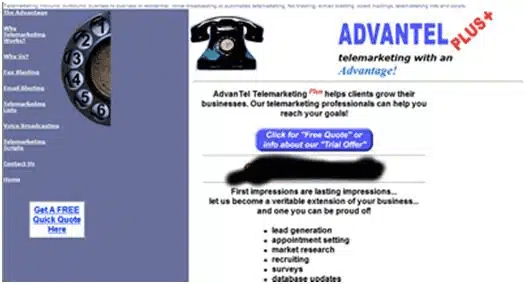
Keep in mind that trust is an essential part of the selling process offline as well.
Consider this: would you trust a poorly kept storefront in a bad area of town?
In this chapter, we explain about the four stages of “The Trust Circle”: awareness, knowledge, liking, and trust. We present the concepts of value proposition, continuity, and congruency, along with a list of questions to help you improve all three of these elements in your website. We also introduce social proof techniques you can use to enhance visitors’ trust in your site.
The Trust Circle
“The Trust Circle” refers to the phases of establishing trust with customers and enhancing their confidence in your company. From an online selling perspective, the four stages below unfold in a matter of seconds:

1. Awareness: This is an initial getting-to-know stage. Potential customers run across an ad, or you pop up in search results. They have now become “aware” of you, which is an opportunity in itself.
2. Knowledge: Awareness drive them to you, but you have just a couple of seconds to explain what you are all about. This is where the value proposition is essential, so crafting and designing the right one is crucial.
3. Liking: If you give them the knowledge they need to stick around, and they browse the site more and more, they have entered the “liking stage.” During the liking stage, you should address visitors’ questions such as: do I know enough about what this company does or has to offer? Can’t I go to a more well-known established name and get these products or services? If you succeed in moving visitors through the liking stage, you have gained them as a customer, at least once.
4. Trust Stage: Your visitor just made a purchase. Congratulations! This visitor trusts you. Of course,it is now essential to ensure he has a pleasant experience when receiving the product and services. As this customer trusted you enough to make the purchase, confirm the reliance with a successful post-purchase experience. Up to the point of having the product in their hands, visitors are still anxious about the purchase they just made. Assure them a satisfying experience by shipping in a timely manner, ensuring that the product is in pristine condition, and making an exchange or return as seamless as possible.
Here is an overview of areas you can focus on to better establish trust with your site visitor:
- Value Proposition for the company, products or services
- Continuity
- Congruency
- Social Proof:
- Expert Status
- Celebrity Endorsement
- Membership/Professional Organization or Affiliation
Value Proposition
A value proposition is both a promise and a value.It defines the problem you solve for your clients and clarifies the reasons why you stand out from competitors.
A compelling value proposition appeals to the customers’ strongest decision drivers. Identifying the right value proposition and translating it on your website is one of the most valuable activities on doing conversion optimization. Ask yourself:
- How do you distinguish yourself in a very busy marketplace?
- How do you differentiate yourself from the competition?
- Why would people choose to buy from you rather than from the competition?
- How do you define your value proposition?
The first step to creating a compelling value proposition is to learn more about other companies in your field.Make sure you are offering something different in value as compared to your competitors. Your value proposition should be unique, so you can stand out from rest of the crowd and get noticed.
Newer sites rely more on the value proposition, as it provides a way to conquer the initial online anonymity. Well-known companies do not need to introduce themselves to visitors, but they still benefit from maintaining relevance and alluding to the value proposition throughout the website.
Once users identify who you are, what you provide, what you can do for them, and why you are better than the rest, they overcome their first set of confidence issues.
Every element on your website, from the homepage to product pages to site navigation, should support your value proposition. More than a message you want your visitors to read, your value proposition should be an experience you offer throughout your site.
At MeUndies’s website, their value proposition is ‘the world’s most comfortable underwear for men.’ Any man who visits MeUndies knows that whatever they order is going to be the best for them.
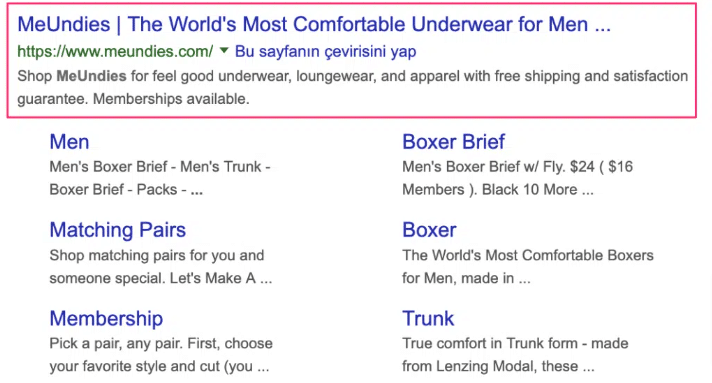
Continuity
Understanding visitors’ motivation or “intent,” can help you address trust and confidence issues on your site. A good way to hone in on intent is by looking at the keywords and ads that inspired visitors to click through to your site in the first place.
Keywords are often loaded with meanings and particular motivations, so researching them helps in understanding your customers and better addressing their needs on the website.
Analyze the relevancy of your landing page to the keyword visitors used.Some companies employ a single, general landing page for a variety of paid campaigns. However, optimized pages that show up inorganic search do not help address visitors’ questions. Funneling all sorts of personas, with varying motivations and at different stages of the buying process, through a single common page usually results in low conversion rates. The challenge is to cater the message and the unique selling proposition to satisfy various visitors’ intents.
“Continuity,” an essential component of trust, is addressed by answering the following questions:
- What brought visitors to your site in the first place?
- How did they get there?
- Where did they land?
- What did they see?
- Was there relevance to what brought them there in the first place?
Continuity refers to maintaining relevance and scent at every touch point that visitors have with your website or campaign. Relevance and scent reflect a continuous theme such as look, feel, offers, and copy.
Continuity becomes especially important when you control the ad that leads to the landing page.
Let’s look at a good example which maintains scent and relevance.

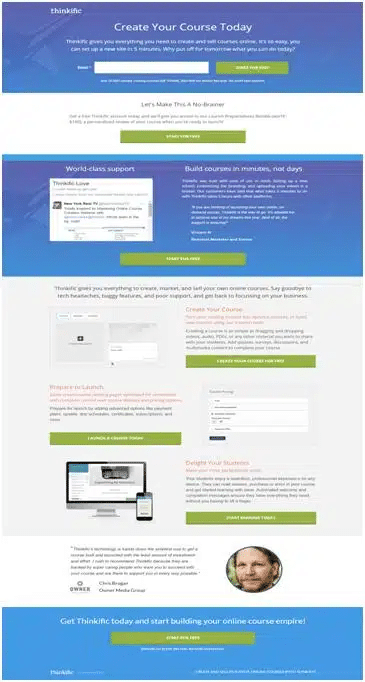
Image source: Thinkific
The ad display and the landing page perfectly match in terms of the offer (create your own website), ad copy and the value proposition. The ad states that visitors only need 5 min. to create their website. It is written in a way that makes people think: “Of course I have 5 min. to create my own website.” On the landing page, they justify this proposal with testimonials, step-by-step explanation with pictures, and special features (as world-class support).
In another example, we can see that there is a significant difference between the ad display and the website. This is a pretty bad example of maintaining scent and relevance.
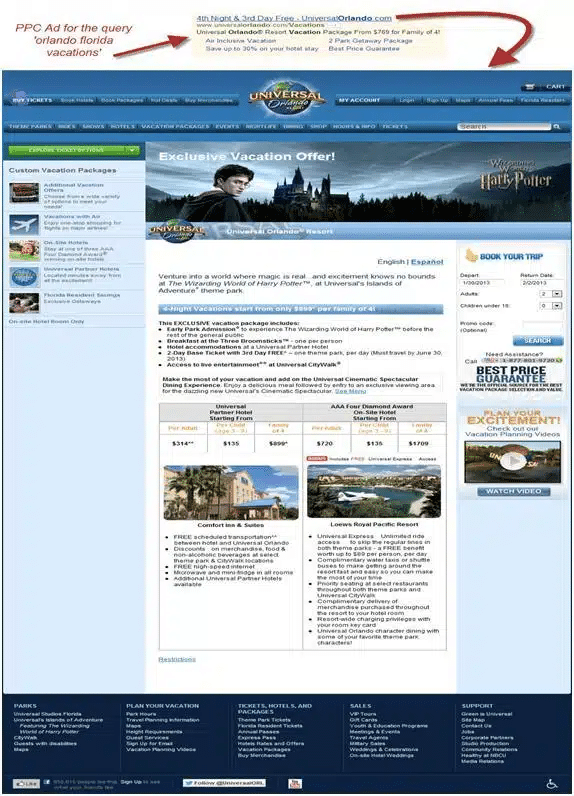
Image source: Digital Marketer
What happened to the $769 offer in the ad? You can see on the website the cheapest option is $899 per family of 4. What about the 30% off? No matter how big or small your company are, you should be careful about giving the exact information your visitors are seeking for.
Both scent and relevance must work together to increase users trust by ensuring them they have landed on the right page and confirming your page is relevant to their inquiries. But it does not stop there. As visitors navigate through your website, the same themes should continue from one section to the next.
Congruency
Up to this point, we focused on providing visitors with scent and relevance by maintaining continuity from an ad or search result to the landing page.Now, you should check:
- How harmonious are the different elements on the landing page itself?
- Is there a congruent theme and message throughout the page and on every page throughout the site?
Visitors move to the knowledge stage of building trust the minute they land on your website.If your landing page does not address their particular questions, you have not succeeded in building trust. Congruency is the idea of maintaining a single harmonious message within the same page while answering questions of various personas.
For the value proposition to transcend to the visitors,the elements on a single page have to support that value. Very often you find sites with many competing messages on one page.You can also find sites where the copy, images, and elements do not work together to fulfill the value proposition.
The lack of congruency increases visitors’ anxieties and leads to more friction. Friction results when two forces collide. Online, the two forces colliding are the visitors’ anxieties and your landing page elements. The more friction results from the collision, the more likely visitors will abandon the site. It is impossible to eliminate friction completely;every transaction will have some degree of it.However, your job is to reduce it. Any page on your site should serve two purposes:
- Support the overall value proposition of the site.
- Move visitors towards the primary conversion goal for that particular page.
When elements of the page work harmoniously together to accomplish these objectives, you achieve congruency. As you evaluate different pages on your website, you should ask the following questions:
- What is the primary conversion goal for the page?
- Do the page elements (copy, images, and design) support the primary conversion goal as well as the value proposition of the site?
- What page elements are distracting visitors from the primary goal or the value proposition?
- Do all different elements present a single congruent message?
- Are the elements relevant to each other?
Let’s see the example of Breather.The site displays an instant CTA to select a workspace. There is a location service for you to determine where you are and how to get the options close to your point. At the homepage, above-the-fold, you can also select the type of meeting room you need.
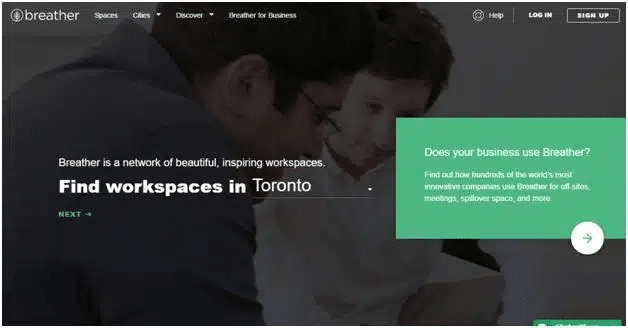
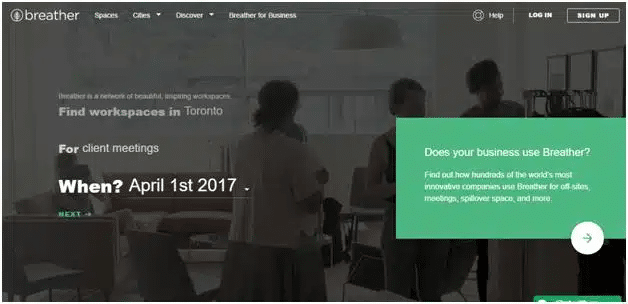
You can see how each element supports the primary goal of the page and the value proposition of the website.
Social Proof
In many cases, your website visitors will evaluate your business based on how other people behave towards you.Find below some social proof techniques you can utilize on your website.
If you drive by two restaurants, one that is buzzing and one that is almost empty, which one would you like to try? Few would give the latter a chance and try it out. The majority would rely on the social proof that “a lot of people must love this place, and I want to experience that too.”
The majority of us, caring personas in particular,have humanistic aspects to our behavior.This is why social proof is critical. If you have many clients or customers, list the exact numbers on your website and see the difference that makes.
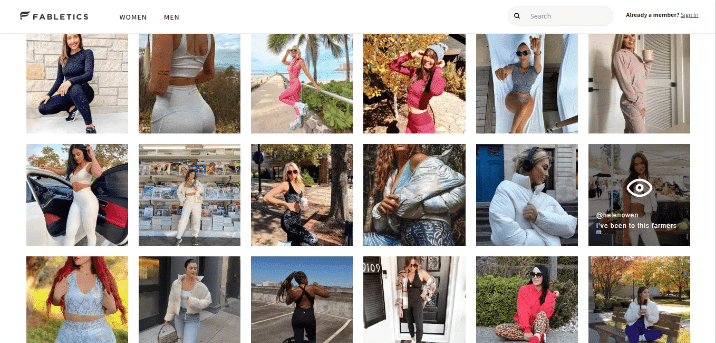
( Source: Fabletics)
Many companies encourage customers to log in via social media accounts and share posts on social media channels. However, still some companies avoid to let customers share products, events or commercials on those channels. The statistics below show that people do take into account social media shares of friends, when making a specific decision about a specific company:
- 75% of internet users use social media to research products
- 71% of consumers who have had a positive experience with a brand on social media are likely to recommend the brand to their friends and family
- 49% of consumers claim that they depend on influencer recommendations on social media to inform their purchasing decision
- Consumers are six times more likely to make a purchase from a product page that includes pictures from social media (hint: don’t neglect UGC).
- Social media users overwhelmingly trust other users as their “preferred” form of influencer, most likely to buy from them based on a product recommendation (37%) versus celebrities (7%).
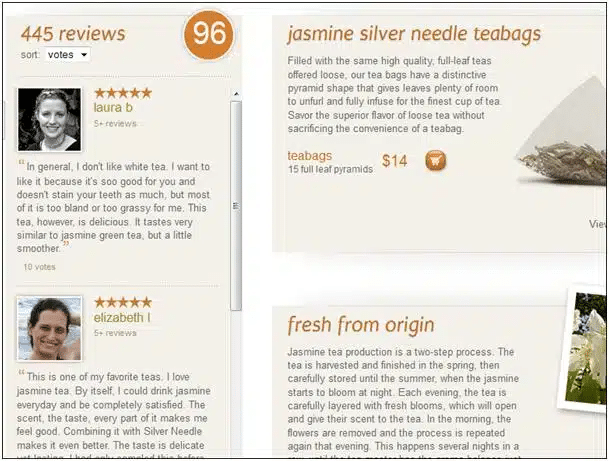
Adagio Teas uses reviews to influence prospective buyers, with the idea that “If others like this tea, then maybe I’ll like it as well.”
Expert Status
For most industries, publishing researcher speaking at conferences gives your visitors a boost in confidence in what you have to offer.
First and foremost, speaking on a specific work-related topic automatically coins you as an expert. In the business world, whatever your specific vertical may be, this means a lot.
Media Mentions
How many times have you read, on an ad or website,the expression “As Seen In”? If your company has been mentioned on CNN, the Times, or any other industry related or reputable media outlet, definitely remark your media presence on your website. It is excellent social proof, and it will gain you the trust of your visitors and future customers.
For instance,this is what Glossier has on their homepage:
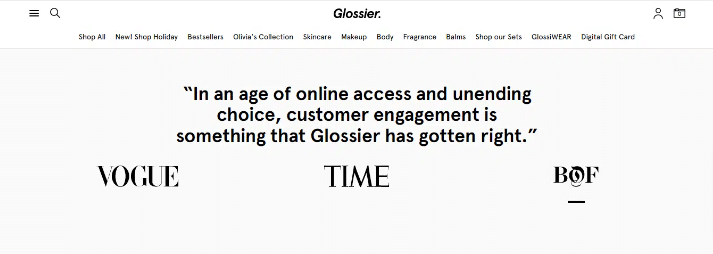
Here’s another example from Casper’s website.
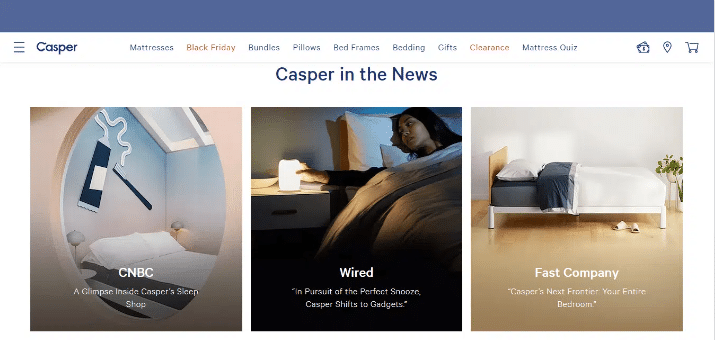
You may not have appeared in the press yet. However,even some blog mentions displayed on your homepage can help you. If you have been included as a guest writer on a popular blog, or have been mentioned by them,this also helps you to gain trust from your visitors.
Celebrity Endorsements
Any product that wants to make a big splash needs to get notorious personalities to try and endorse it. People desire to resemble celebrities. If they see a famous person using and enjoying your product or service,you can be sure that you have gained their trust and confidence. Influencer marketing has become a buzzword, with Google searches rising 69% since May 2015.
A study conducted by the collaboration of Experticity,Keller Fay Group and Dr. Jonah Berger assessed the impact of participants’ recommendations. In the study, 6,022 U.S. individuals answered about the“likelihood to follow recommendations and perceived credibility of source (Influencers vs. average customers).”The recommendations by influencers outperformed recommendations by average customers:
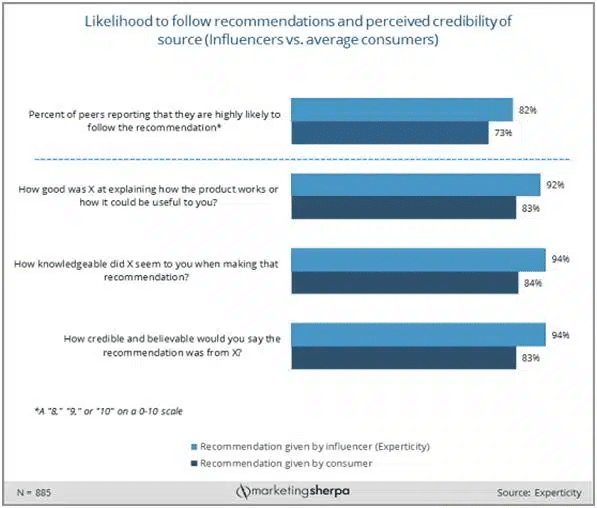
Image source: Marketing Sherpa
See this example of Selena Gomez using her celebrity status to promote her brand Rarebeauty;

Drawing a conclusion
If you want to increase your conversion rate, answer to yourself, “Why a customer should trust you in the long run?” Use a compelling value proposition to answer this question, and search for supporting elements to gain your visitors’ trust, to complete continuity, congruency, and social proof of your page.
Resources You’ll Love
Effective website navigation (even if you’re not a usability expert)
A Step By Step Guide To Turn Your Homepage Into High Conversion Machine
10 Most Common Trust Related Problems Affecting the Conversion Rate of Your Website
Optimizing your sales funnel into a marketing funnel



